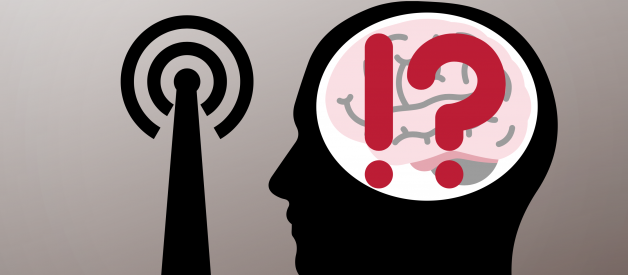What happens when mental illness becomes coordinated

You wake up, rub your eyes, and get out of bed. You pull aside your window shades to see your neighbor outside, weeding his garden.
He?s started early today. He?s doing it to taunt you. He wants to prove that he?s better than you, to make you look bad. He acts like he ignores you, but his passive aggression is blatant. You know he wants your attention, so you do your best not to give it to him.
You eat breakfast, shower, and head to work.
On the freeway, two dark SUVs pull up beside you. You check who?s in them, and there?s a person looking back at you. Staring. Waiting for you to make even a small mistake. Daring you. You focus hard on your driving, becoming acutely self-conscious. Finally, they drive off, and when they do, you look behind to see a squad car. It?s not a coincidence. You?re sure of it.
You arrive at work, but things in your office aren?t where you left them. Your garbage can is moved, your stapler is missing, and your computer is warm ? as if it was just being used. Someone has been there.
Why do people do this to you? Why do they care so much about you?
You don?t know their purpose, but you know their goal is to ruin your life. To drive you into frustration, anger, and despair. They want to make you seem crazy ? but you?re not crazy. You?re sure of it.
The taunting follows you to cyberspace. Your email inbox is flooded with advertisements from companies you?ve never patroned. Some emails know intimate details of your life. All of them know your name.
You also get daily emails from people from far away asking for your help. You know they?re fake, so you delete them, but they still annoy you.
As hard as today was, it was a good day.
On bad days, the stalkers use advanced government technology to pummel your brain with radio waves. Those waves can make you do nearly anything. They can cause anxiety attacks, they can make you very, very sad, and they can make you hear voices that tell you to do dangerous things. You know the voices aren?t real and you try not to listen to them, but sometimes it?s hard.
You don?t have many friends. Everyone you meet is either part of the conspiracy to harass you or they don?t believe the predicament you?re in. Real friends would believe you, right?
Right?
This is a day in the life of someone who has fallen prey to an internet conspiracy theory called ?gangstalking.?
The gangstalking theory began when hundreds, then thousands of people with medical conditions that cause paranoid delusions found each other on the internet, bonded over their shared delusions, and worked together to form a common narrative for their daily experience.
The prevailing theory they have settled on is that they are being taunted, targeted, and teased by covert government or corporate entities. In reality, though, these people are most likely suffering from an untreated, undertreated, or untreatable mental condition like paranoid schizophrenia.
PARANOID SCHIZOPHRENIA
The remarkable mental disorder of paranoid schizophrenia is key to understanding the gangstalking conspiracy and why it is dangerous.
Paranoid schizophrenia usually starts in adolescence or late adulthood. Exact causes are unknown, but genetics and environment likely factor in. The disorder affects people from diverse backgrounds and across socioeconomic strata.
According to WebMD:
?Schizophrenia is a kind of psychosis, which means your mind doesn?t agree with reality. It affects how you think and behave. This can show up in different ways and at different times, even in the same person. The illness usually starts in late adolescence or young adulthood.
?People with paranoid delusions are unreasonably suspicious of others. This can make it hard for them to hold a job, run errands, have friendships, and even go to the doctor.?
The illness can be debilitating. If untreated, it can drive people into isolation, making them afraid of society. The delusions are exhausting and can ruin a person?s social support group.
According to WebMD, the delusions can take many forms, including believing:
?A co-worker is trying to hurt you, like poison your food.
Your spouse or partner is cheating on you.
The government is spying on you.
People in your neighborhood are plotting to harass you.?
Along with delusions, schizophrenia can cause hallucinations. These can be visual, as in ?seeing things,? or auditory, as in ?hearing things.? Visual hallucinations may be subtle, such as seeing a flat wall that bulges outward, or they can be startling, like seeing demons in a home or having a nonexistent pet.
The voices in the auditory hallucinations can be both encouraging or insulting, though many people report that, when schizophrenia is untreated, insults rule the day. Resources such as the one created by WebMD below exist to help outsiders understand the auditory hallucination experience.
Schizophrenic hallucinations and paranoid delusions may make people feel as if they are being followed, harassed, watched, or stalked.
In a 2014 study, two groups of 128 people each were examined. One group claimed they had a singular stalker while the other group claimed to be victims of group or gang stalking. The study found:
?All cases of reported group-stalking were found likely to be delusional, compared with 3.9% of individually stalked cases? The group-stalked [group] scored more highly on depressive symptoms, post-traumatic symptomatology and adverse impact on social and occupational functioning. Group-stalking appears to be delusional in basis??
This study provided overwhelming evidence that people believing they are being gangstalked are likely suffering delusions. While paranoid schizophrenia is one of the most prominent likely contributors to gangstalking delusions, other conditions and environments have potential as well, such as delusional disorder, dementia, substance abuse, medication side effects, lack of sleep, and more.
THE BIRTH OF THE GANGSTALKING CONSPIRACY
Schizophrenia is rare, affecting barely over 1% of the population. Subtypes of the disease with potential to cause stalking delusions are even rarer.
In the pre-internet era, people with severe undiagnosed or undertreated schizophrenia usually withdrew from society and had no voice in their communities ? they certainly didn?t communicate at length with others in the same situation.
But that changed with the internet.
Now, people with delusions could share their personal experiences on blogs and internet forums. With time and luck, they found each other and built internet-based communities to interact with each other.
In the quest to explain their paranoia, the newly-organized group of interneters-with-delusions began constructing a collective narrative that eventually bloomed into a full-legged conspiracy theory, or at least a cluster of semi-legged conspiracy theories.
The common thread through the theories is that people who are feeling constantly harassed, stalked, or followed are among a group called ?Targeted Individuals,? or ?T.I.s.? These people have been chosen, either for a particular reason or just by chance, to be targeted with coordinated stalking.
Reasons people may believe they have been chosen can be almost anything. Some believe their stalking is based on their sexuality, others believe it?s revenge for a past unethical act, and still others may believe their stalking began when they stumbled too close to a conspiracy secret
The nuances of the gangstalking world are complex, but before understanding it, it is imperative to know that people who claim to experience gangstalking are not making anything up.
To them, the world they have constructed is just as real as the world everyone else sees, smells, tastes, and touches. Their fear is real ? and they aren?t being overdramatic or begging for attention. They truly believe in the things they say they do.
THE GANGSTALKING CONSPIRACY
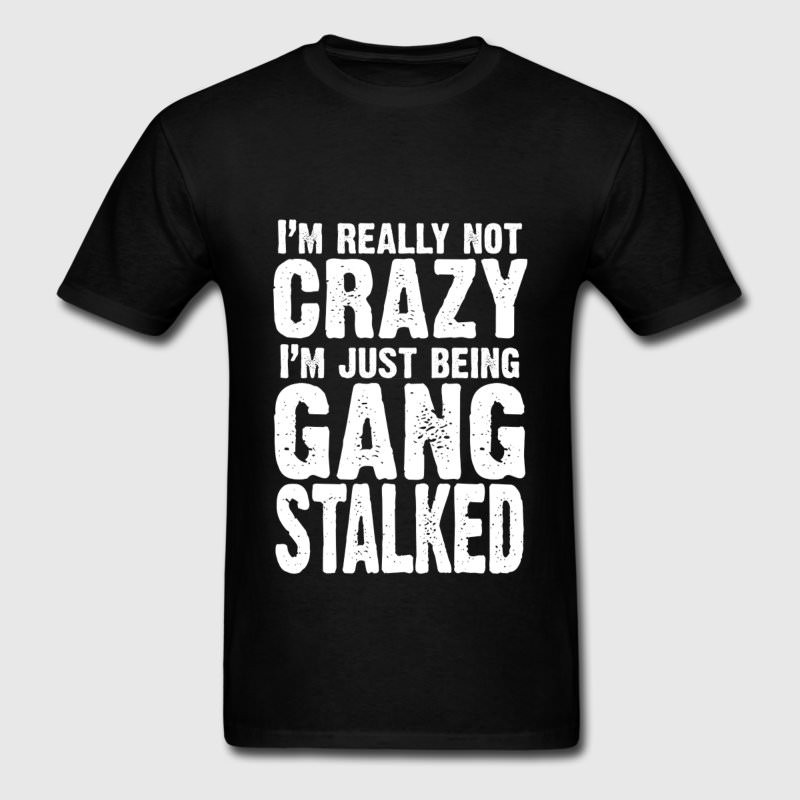 A t-shirt design for T.I.s
A t-shirt design for T.I.s
The world of gangstalking is muddled and confusing. There are no sharp edges, no domineering narratives, and no illuminating deep dives by the media. There is also no obvious leadership ? either from a group or a person. The movement is scattered geographically, cyberspatially, and ideologically.
The definition of the term ?gangstalking? itself is debated.
Some people use the term in a context completely separate from the delusion-based conspiracy, and instead use it to describe gang activity, coordinated bullying, or the few real cases of organized stalking. The term ?Targeted Individual? is also used by people who likely don?t actually suffer from any mental disorder, and simply feel that they are over-surveilled by the government and corporations. But these instances are exceptions to the rule.
For the sake of consistency and precision, in this article, the term refers to the most common, agreed-upon use, wherein people who are likely experiencing delusions believe they are targeted by coordinated stalking from shady, conspiratorial sources.
In a 2016 article, the NY Times reported that the number of people who believe in gangstalking exceeds 10,000 members worldwide, and that number has been repeated in other outlets. In an email, the reporter explained that the estimate is based on numbers provided by researchers and targeted individuals.
Aside from the ridiculous-sounding conspiracy theories and the occasionally detectable physical manifestations of paranoid schizophrenia, the people who believe in gangstalking may be indistinguishable from the rest of society.
In a 2017 article, Joseph Flatley, a reporter writing on gangstalking for The Outline, described the community, saying:
?Everyone (well, almost everyone) I talked to while writing this story came across as credible, as very normal. Targeted Individuals are obviously experiencing something highly traumatic and anxiety-inducing, something they?re at a loss to adequately understand. Otherwise, they all tend to be pretty unremarkable. That is, you probably wouldn?t be able to pick one out in a lineup. If anything, the people I spoke with seemed a little smarter than the average.?
Other documentaries and video news clips corroborate this, depicting believers of the conspiracy community as intelligent, funny, and well-spoken. However, news reporting likely pulls from the more outgoing, socially competent subjects for sources and subjects, as the conspiracy theorists that have retreated from society are unlikely to come in contact with reporters ? much less proactively seek them out.
Schizophrenia presents in many different ways and to differing degrees, meaning there are correspondingly different levels of involvement that one might take in the conspiracy. Some subjects maintain a functional life with employment and social contact while others might be driven to take drastic action such as moving to a different country or purchasing expensive equipment that supposedly stops the harassment.
Over time, without help, those suffering severe delusions may lose their homes, drive away any social support, and could be at risk for extreme depression and suicide.
WHAT THEY BELIEVE
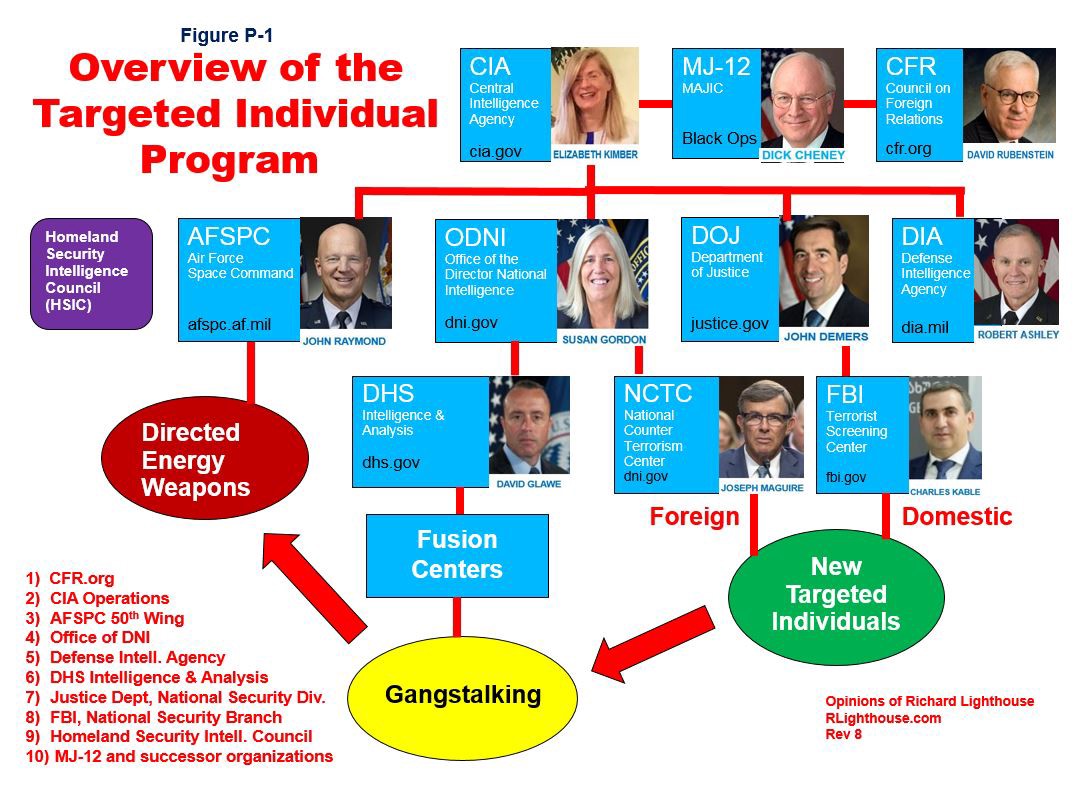 An old conspiracy theory flow chart from a website called ?Targeted Justice?
An old conspiracy theory flow chart from a website called ?Targeted Justice?
A blurred line demarks reason and delusion in the gangstalking conspiracy. The beliefs of those who think they are being gangstalked stem from a strange meld of justifiable concern about personal privacy and delusion-generated fears of targeted personal attacks by a nefarious force.
For example, people who believe they are being gangstalked point to the many verified extensive surveillance forces that institutions use on the general public. These can range from the collecting and selling of internet data to the NSA?s overzealousness that was exposed by Edward Snowden. Conspiracy theory believers are not wrong to have concerns about these issues. They cross the line, however, when they think their thoughts are being read or that the car they saw with the tinted windows was sent specifically to monitor them.
Believers may also be hypervigilant against subtler types of control.
For instance, they may feel that they are being targeted by companies that sell addictive products such as alcohol or salty foods. While a healthy person might rationally be annoyed that a corporation is using the human body?s vulnerabilities for profit, a conspiracy believer may believe that the company is trying to take over their mind.
Believers point to past government programs that they believe may be responsible for their stalking.
Two frequent examples are COINTELPRO, an FBI program designed to infiltrate, impede, and dismantle troublesome activist organizations in the 1960s, and MKUltra, a CIA mind control program from the same time.
However, many people who claim to be gangstalked develop theories unique to their situation. LGBT members may believe they are being stalked by anti-gay radicals, ex-felons may believe their local police department is following them, and people with thorny romantic pasts may believe a former partner has hired personal investigators to tail them.
Though the specifics of the gangstalking theories vary, all of them center around one problem: That shady people are following them and are trying to make their lives difficult.
To fight back against perceived oppressors, they have created communities, both in real life and online.
GANGSTALKING COMMUNITIES
The gangstalking conspiracy is woven through blogs, websites, forums, and social media pages, composing a bewildering sprawl of characters and narratives.
The most official-seeming hubs of the movement are the websites. One of the top search results is titled ?Stop Gangstalking Crimes.?
Despite claiming a recent update in March 2019, the site?s graphics hail from a far more primitive internet.

Past the painful user interface, the site hosts links to petitions, current activist efforts, general discussion forums, and PDFs that purportedly prove the existence and proliferation of mind control and surveillance technology.
Another site, titled ?GangstalkingIsMurder,? hosts FOIA?d documents relating to stalking that supposedly prove that gangstalking is real. The site encourages visitors to call their congressperson, saying that if you don?t, ?your silence will ensure that [gangstalking] will not end in the foreseeable future.?
?Targeted Individuals Canada? has advice for those suffering from gangstalking on how to get through the difficulties. It reads:
?First, stay healthy, eat well and exercise.
Second, if you decide to be active online, no matter what you do, make sure you present yourself well. This is always about perception. Do not make yourself look you are losing it. Your sanity is the number one goal, do not lose it.
Third, live your life, do the things you enjoy.
Fourth, do not isolate yourself to everyone.
Final word for you, no matter what you do, Learn to filter and ignore. Stay positive and refocus to the good things. Do take care of yourself.?
The gangstalking community, like any burgeoning socio-political effort, has some prominent activists. Targeted Individuals Canada hosts content produced by one of these activists named Eleanor White. White?s name can be found referenced across the gangstalking world in blogs and videos.
White made a series of comics called ?Targ the Target? that illustrate what it felt like for her to be a subject of gangstalking. Reading them offers insight to the strange mindscape of conspiracy believers.
Over 23 ?episodes,? the story explains how stalking starts, then drives a person to appear unstable, and finally takes away things that are most important to them. In Eleanor?s case, her children.
Episode 1

Episode 2
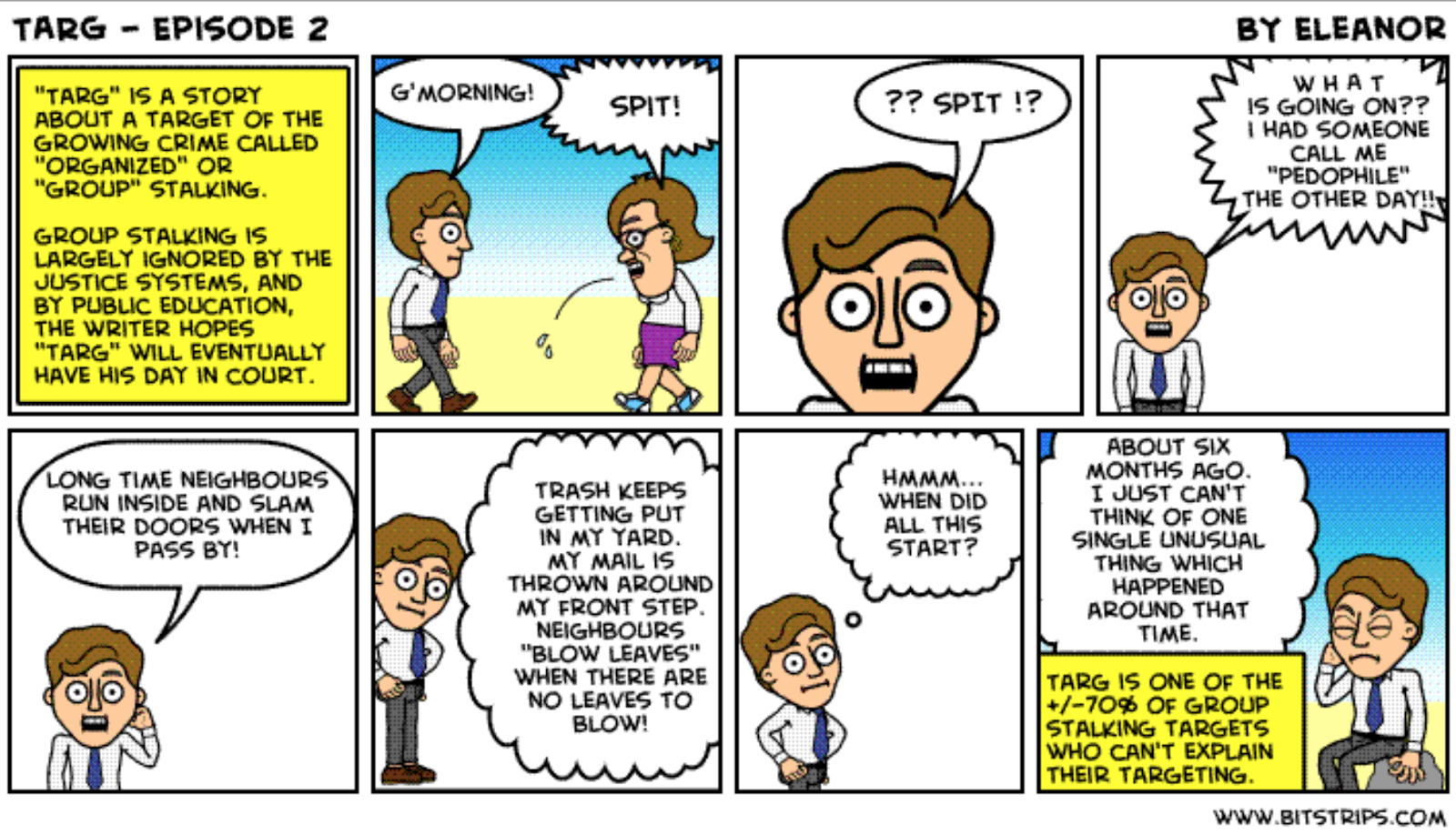
(skip to) Episode 23

A more current activist developed a modern-looking website titled, ?Stop Gangstalking ? Awareness Group.? The site?s administrator was referred to via pseudonym in the previously mentioned story from The Outline. As gangstalking sites go, the Stop Gangstalking ? Awareness Group has a broad focus.
It tackles everyday stalking and abduction related crimes, though its greatest emphasis is on the conspiracy theory version of gangstalking.
In an email, the administrator of the site explained that while the group?s in-person activist efforts are at a standstill, his online content is still receiving attention through the website, social media, and the sale of merchandise such as the t-shirt below.

Along with running social media pages and the website, the site administrator is a moderator on Reddit?s gangstalking forum called ?r/gangstalking.?
The forum has only 8,000 subscribers, but forum statistics show that it is growing exponentially and it currently receives about 3 posts each day, emblematic of a modest but steady community.
Some of the most popular posts on the subreddit actually express concern about the influence it might have on people with paranoid delusions. One such post, titled, ?This sub is so toxic for people with delusions,? reads (edited for clarity and grammar):
?I?m going to get a lot of downvotes for this, but this place makes me so fucking paranoid I cant stand it. Everyone is just feeding each other?s delusions. I?m scared to leave my house and live a normal life. I?m scared I?m always being watched.?
The top posts of all time on here are saying this exact same thing. This sub is unbelievably harmful. For those of you who are prone to delusions and paranoia, just leave. This place isn?t going to help you. It?s going to make you worse.?
A similar post is more direct about the concerns of schizophrenia. It is titled, ?How can you support this?? And it reads in part:
?Most of these posts describe symptoms of acute psychosis or schizophrenia. The thing about these illnesses is that while it?s happening you have no idea, you only realize how delusional you were after you begin to recover. I?m disgusted by the mods feeding these delusions, you could be responsible for something very serious because these ill people are being pushed further and further into this fucked up headspace by a whole community of alike people.?
But aside from these posts, most of the content is from believers in the conspiracy.
The community consists of people brought together by an earnest need for someone to trust, yet it is fraught with dysfunction because undiagnosed or undertreated paranoia has made intra-group trust impossible.
The result is bizarre.
One post contains a tirade accusing all of society for being part of a plot to make the author seem delusional. It reads, ?It?s not just gangstalkers, everyone in your community and in communities at large are against you and wouldn?t bat an eye if you were disposed of (through any means).?
The comment section of that post exposes the rampant mistrust between community members. One commenter, somehow convinced that the post was by a stalker, wrote, ?This is literally the message that the gangstalkers throw at people you dick. Fuck you. I would advise you to make this your last post here. You outed yourself.?
Another post muses about the genders of targeted individuals, asking whether it?s only cisgendered people who become targeted, adding that, ?I started to notice that the people gangstalking me exhibit traits of in-utero transgendered people.?
A terse response reads, ?Transgender agenda? OK bigot. Do you believe in white genocide too??
Other posts in the forum expound on the utter strangeness of the conspiracy.
One user claims that their stalkers are part of a ?neighborhood watch type thing or something similar? that have been putting the same license plates on different cars and then using those cars for stalking.
Another user wrote that they were feeling genital pain caused by gangstalking, writing (edited for clarity), ?I thought some super strong UTI was coming on, but I couldn?t even get on to the bus. I had to go to my boyfriend?s and take pain killer and it calmed down. And it happened when I was right near a bunch of power lines.?
A commenter responded (edited for grammar):
?It?s possibly nanotechnology they attack people with. It enters through the skin and around fingernails. Gives people that crawling insect sensation. It first goes to the brain and begins sending and receiving signals, causing the ear to ring and buzz. The nanotechnology has many capabilities. I removed it from myself and since that day, 9 months ago I have had zero health problems, and zero harassment.?
The commenter later explained his method for getting rid of the nanotechnology. It involved cinnamon, olive leaf extract, turmeric capsules, cocoa powder, a chocolate syrup scalp massage, and some very hot water to submerge the hands and feet.
While weird, the process probably didn?t cause any lasting harm. However, cases like this have driven conspiracy believers to attempt self-surgery to remove what they think are government implanted harassment devices.
This, obviously, is extremely dangerous.
The Reddit forum offers a look at the conspiracy through the eyes of the believers and it provides evidence that the gangstalking conspiracy is of a new breed ? one with potential for unprecedented harm.
There is no common narrative, no shared set of facts, and no agreed upon bigger picture. The only force that brings together the believers is a sense of profound fear of everyone else.
Gangstalking content is on traditional social media as well.
On Twitter, users post with #gangstalking to show they are part of the targeted individual community. Some tweets contain statements of solidarity with other believers, while others contain alleged evidence of their stalking.
In one particularly overt instance of misled paranoia, a gangstalking Twitter account posted a screenshot of a Google search result for ?gangstalking.? The image shows a job search website that autofills its headline to match the user?s google search, but the user read it as a legitimate result.
Visiting the link in the image does not elicit any employment opportunities related to gangstalking ? but somehow, through 50 retweets, 52 likes, and 11 responses, only one user (a self-described T.I.) pointed that out.
On Facebook, content is found on the personal profiles of proclaimed gangstalking victims, on pages, and in groups. Subjects in groups often share videos of their supposed stalkers, though as an outsider, watching those videos reveals nothing out of the ordinary.
The conspiracy exhibits many characteristics similar to internet cults ? adding an extra level of danger for those who fall for it.
The Gangstalking Cult
Cults often develop their own vocabulary that is common to the members of the in-group, but alien to outsiders.
Shared rhetoric strengthens the sense of belonging in a group. The time invested in learning it raises the bar to entry and, via the sunk cost fallacy, raises the bar to exit.
One obvious example is the identifier ?Targeted Individuals.? By calling themselves T.I.s, members implicitly state that they aren?t alone, and that at the level of their identity, they are part of an exclusive group that is innately different from everyone else. A ?chosen? group.
The community also has abbreviations and acronyms that they use fluently.
For instance, ?Psy-Ops? refers to a type of surveillance operation that supposedly remotely transfers information to the brains of targeted individuals to affect their emotions and logic ? in other words, mind-control.
And the acronym ?V2K? stands for ?Voice to Skull? technology that gangstalkers supposedly use to make targets hear voices. In reality, the voices are caused by auditory hallucinations related to schizophrenia.
One self-described targeted individual quoted in The Outline explained how V2K technology allegedly feels:
?It?s not like you?re being zapped, but you just hear a noise. But the noise, it doesn?t sound ? you can tell when you hear it, it doesn?t sound like it?s external. You hear it as a sound, it has a clear property, like a noise or a sound, but it doesn?t sound like it?s coming from around you. It?s hard to describe, but it?s real. It?s totally real.?
The conspiracy theories, some of which are intricate enough to almost be a type of paranoia-infused lore, also have cult-propagating properties.
The theories are intricate and time-consuming to learn. Once accepted, they are difficult to discard. They consume a person?s entire world view, casting doubt on everything they once believed.
Among these theories are the ideas that COINTELPRO and MKUltra are still in robust operation, that freemasons are a prominent conspiratorial force in society, and (in an extreme example) that lizard people have quietly conquered both Hollywood and the U.S. Government.
The cult aspects are also evident in the way the members of the in-group are told to view the outside world.
On many websites and internet forums, readers are discouraged from visiting psychiatrists, as they will be told they are crazy and may be institutionalized. In some instances, readers are warned that their harassers will design their harassment so a target will feel like they have all the symptoms of paranoid schizophrenia, thus, all advice from healthcare professionals should be ignored.
One comment reads:
?They are attacking you. You are not paranoid. You do not need mental health treatment. The system is rigged. The TI community will help you. It?s OK to stop the meds.
?Don?t expect anyone in your family, police or mental health to understand. There?s a long and successful campaign in place to make you look crazy to those people.
?
?Find the TI communities on reddit, youtube, social media. There?s a podcast called [name omitted]. Join these communities. Tell your story. Ask to be understood. They will believe you. They will validate your experience. They will never shame you, because your response was 100% human, and there?s no shame in being human.?
Content like this drives people away from healthcare professionals and the help they need, while hurling them head first into the cult and its associated perils.
Conspiracy believers feel persecuted by the outside world, and it?s clear why.
They are constantly disbelieved, and the louder they protest and try to explain their situation, the more they are ridiculed and ostracized. They might see other believers losing their self-determination and, fearing that they are next, decide to keep their beliefs between themselves and other internet conspiracy theorists.
Together, these many factors create a storm that sucks susceptible targets into the conspiracy and keeps them there, all while cultivating distrust in the people who can actually help. Believers quickly find themselves completely alone ? save for the echo-chamber of online gangstalking communities that repeatedly tells them that terrifying, powerful forces have conspired to ruin their lives.
GANGSTALKING IN THE MEDIA
 A photo from a VICE documentary
A photo from a VICE documentary
News coverage of the conspiracy is sparse ? partly due to the small scale of the movement and partly due to the difficult task of parsing out the gangstalking conspiracy from other types of conspiracies.
Some prominent news outlets have covered the topic, though.
The news outlet VICE released two documentaries, one short and one long. The longer instance, ?Meet the Targeted Individual Community,? is a stellar dive into the movement, offering insight into the daily lives and fears of self-described T.I.s.
The documentary is hosted by Matt Shea, who masterfully maintains the trust of the subjects without validating their beliefs ? a necessary tactic for simultaneously getting the story and doing no harm.
The online magazine WIRED also had two stories mentioning the topic, both from 2018. The most recent article, from Laura Yan, explained the difficulty of building reportorial connections with a community, knowing she might have to violate their trust with the final published story. Yan had attended a multi-day conference for T.I.s with speakers and documentaries.
?Sometimes T.I.s asked me if I was worried about becoming targeted myself. I told them no, but I was worried ? about what might happen to the TIs and what they might be driven to do. Most of all, I worried that I would disappoint them ? that I couldn?t tell their story the way they wanted it to be told.
?Liza and the other TIs told me, again and again, that the worst part of being a T.I. is not having people believe you.?
Yan?s instinctive concern for the safety of the T.I.s (and likely for herself) makes sense. When writing on subjects of suspect mental health, it is often difficult to trust that the coverage you give them will not become a reason for retaliation ? against you or another member of your profession. But as explained earlier, the likelihood of targeted, vengeful violence from people with paranoid schizophrenia is low.
The NY Times has also published on the topic more than once. Their more recent article from 2016 was titled ?The United States of Paranoia: They See Gangs of Stalkers.?
The article offered both personal narrative and the broader picture, repeatedly impressing that the conspiracy theory is not valid and that it stems from mental illness.
?Mental health professionals say the narrative has taken hold among a group of people experiencing psychotic symptoms that have troubled the human mind since time immemorial. Except now victims are connecting on the internet, organizing and defying medical explanations for what?s happening to them.
?The community, conservatively estimated to exceed 10,000 members, has proliferated since 9/11, cradled by the internet and fed by genuine concerns over government surveillance. A large number appear to have delusional disorder or schizophrenia, psychiatrists say.
??these individuals represent an alarming development in the history of mental illness: thousands of sick people, banded together and demanding recognition on the basis of shared paranoias.?
The article also describes the echo chambers that the conspiracy festers in and the ornate amalgamation of conspiracies that comprise the world of gangstalking.
The 2016 Times article is significant because it is (as of this writing) one of the first Google results for the term ?gangstalking,? meaning people researching the conspiracy online will have an accurate first introduction.
The first page of Google also houses the VICE documentaries and a Medium post by James Crocket.
But surrounding these links on Google is material that propagates the conspiracy, such as a link to #gangstalking, an Amazon link to a book on the topic, and the website Stop Gangstalking Crimes (discussed above). Each of these Google results raises the likelihood that the internet-borne conspiracy will suck someone into its echo chamber.
While most articles in professional media cover the topic appropriately, some miss the mark.
For instance, ITV News, a British TV news outlet, ran a story on what they called ?gangstalking? that illustrated an instance of stalking by a group that may have actually been legitimate ? not a case of paranoia. However, the rhetoric used makes it sound similar to what gangstalking believers perceive as happening to them daily.
In another instance, a freelancer for a blog called Family Orbit wrote a 2017 article about gangstalking as if it is a term used for groups of children bullies. They produced the below image that conflates the conspiracy with a real world problem.
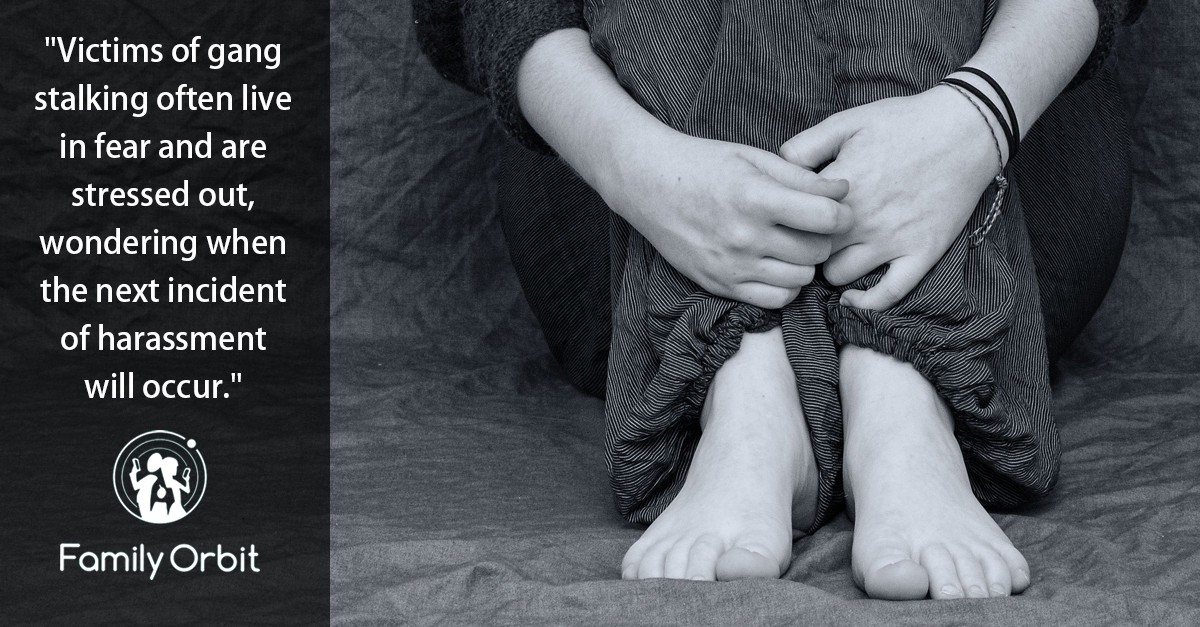
Murkiness in the media can validate the gangstalking theory in the eyes of the believers and it misleads outsiders who want to understand what gangstalking actually is.
Aside from the 10,000 members statistic provided by the NY Times (itself an admittedly sketchy estimate), almost all media coverage is devoid of serious factual reporting. Most stories focus on anecdotal evidence that insinuates a larger problem and almost no stories do deep analysis of the internet content.
The limited media coverage of gangstalking has pros and cons. One pro is that it makes the topic hard to stumble upon by accident. If a person with schizophrenia never stumbles on the conspiracy, they will never fall prey to it.
However, if the media ignores the topic, then the gangstalking echo chamber will persist unchallenged and the public?s attention won?t be called to the growing problem.
This raises a question: How should people communicate effectively with those in the conspiracy? And what can be done to help alleviate the bigger problem?
HOW TO TALK TO SOMEONE WHO BELIEVES IN GANGSTALKING
Author?s Note: The author is not a medical professional and the best outcome for interacting with people who believe in gangstalking will result through consulting professionals.
 A graphic from WIRED
A graphic from WIRED
?Gangstalking is nonsense. Look at your lives, none of you are probably very fucking important. You are on a damn reddit thread. What kind of loserly-assed gang would waste their time following your unimportant ass around??
??you?re not special, you?re not any kind of important people, there are absolutely ZERO reasons to stalk you. I repeat, your life is not unique, it is not special, it is not interesting to anyone but you.?
?Everyone here needs help. What the fuck is this subreddit??
These three quotes from the gangstalking Reddit forum are exemplar of how not to communicate with gangstalking believers. They drive people away from society, corrupting their ability to trust outsiders.
Instead of frustration and anger, use empathy and compassion.
In her piece for WIRED, Laura Yan wrote of an experience she had with one proclaimed T.I..
?Months after the conference I got an unexpected email from another T.I.. She was an artist who wore a hat trimmed and lined with copper to block out radio waves. She was lovely and memorable. I?d comforted her briefly at the conference when she had a fit of unhappiness. Her email was brief: She offered to talk about her experience and attached what she said was evidence of her targeting and photos of her paintings. ?You were very nice,? she wrote, ?and that is rare for us to experience.?
?I broke into tears when I read it, imagining a life in which such a small kindness would be so hard to find.?
Yan?s recounting underscores how desperately compassion is missing from the lives of believers. In their world, everyone is out to get them. Everyone is a potential harasser and may pose a threat. They can?t trust anyone and they feel safe nowhere.
To remain compassionate, it helps to know how anger might arise.
Some people mistakenly think that believers in the conspiracy are arrogant or self-important since they believe that an organization is spending tremendous resources to monitor them.
Or, people may think that belief in the conspiracy is simply a bid for attention. This misconception may stem from the fact that many people with schizophrenia appear to be lonely.
Or, it may seem that a person is simply being stubborn and refusing to live in the real world, preferring the more colorful fantasy world in which they have significance.
But to remain compassionate, it is crucial to know that claims of gangstalking are not founded in arrogance, not just attempts at getting attention, and not a result of stubbornness. The situation is not a result of the vices of believers. It?s simply a product of a medical condition.
Anger, then, is counterproductive. It can only serve to drive a subject further away from society into perilous isolation.
But while empathy and compassion are critical to a productive conversation, validating delusions can also cause harm. So instead of saying, ?yes, you?re right, how can I help,? say, ?it must be scary to feel that way, what can I do to help you get through this??
Put yourself in their place and acknowledge how frightening it must be to believe what they believe, but never validate their delusions.
Remember that people suffering from schizophrenia are not exceptionally prone to violence, but safety should still be a priority. The risk of violence varies depending on exactly which symptoms or delusions a person experiences.
Suicide is a serious concern for people with schizophrenia, especially those with the most potent cases. If someone is showing signs, appropriate steps should be taken immediately (National Suicide Prevention Hotline).
In all cases, professional help is best. The goal of any conversation with people who believe in gangstalking should be to encourage them to seek professional help, through which they can get proper treatment to improve their quality of life.
Keep in mind, though, that someone may have the best intentions and may do everything right, but still fail to help a gangstalking believer. That?s not anyone?s fault, it?s simply emblematic of the difficulty of the situation.
WHAT CAN BE DONE SYSTEMICALLY
The gangstalking conspiracy is not world threatening. It is not a national crisis. A panicked rush to prioritize this problem above all else is not called-for. While the Times? conservative estimate of 10,000 affected people is certainly higher than the ideal number of zero, on a worldwide scale, 10,000 is miniscule.
All the same, there are some steps that can be taken to help people find their way out of the conspiracy ? or to prevent them from falling in.
One easy step is to invest in further scientific research. A better understanding of how paranoid delusions work and what makes someone fall prey to a conspiracy will allow web designers and forum admins to better optimize for the well-being of mentally ill users.
Removing barriers to medical care, increasing public awareness of schizophrenia, and eliminating the stigma around mental illness will also help increase the chances that someone gets the care they need before they fall for a conspiracy theory.
Schizophrenia has a substantial stigma around it. Because of slang terms like ?schizo,? and the ridicule associated with ?hearing voices,? people who believe they are suffering from schizophrenia may be loath to come forward. Subjects may fear social ostracization because of how poorly schizophrenia is understood by the public.
One tool that can improve understanding around auditory hallucinations is a schizophrenia simulator. Some versions can be found on YouTube.
In a piece for CNN, Anderson Cooper wore a simulator and learned the struggle of carrying out relatively simple daily tasks.
Internet forum sites and social media outlets also have a role to play.
Dr. Ralph Hoffman, a psychiatry professor at Yale, suggested in a 2008 NY Times article that making the conspiracy theory difficult to access is beneficial.
?The views of these belief systems are like a shark that has to be constantly fed. If you don?t feed the delusion, sooner or later it will die out or diminish on its own accord. The key thing is that it needs to be repetitively reinforced.?
Online forum sites like Reddit could require gangstalking conspiracy forums to be impossible to access except by personal invitation. And Twitter and Facebook could take similar steps like de-indexing hashtags or censoring particularly dangerous content, such as that which incites violence or self-harm.
Forums could also prominently display messages explaining that beliefs in group stalking and mind control may be symptoms of mental illness. Links to details on schizophrenia and how to get treatment could be required to be displayed prominently.
News outlets have a responsibility to tell the story of gangstalking properly. If an unwitting local reporter gets a call from a source claiming they were stalked by a gang, the reporter may file a story thinking they got a juicy, small-town drama, when in reality, they are simply validating a mentally ill person?s delusions.
In many cases, it may be best for outlets to simply avoid the topic unless they have the resources to research the story effectively.
When these solutions are taken in sum, they still leave a lot to be desired. The tendrils of the conspiracy theory are sprawling and it is impossible to significantly diminish the amount of content currently out there.
However, by slowing down the communities, quelling the cult-like echo chamber, and making sure people are fully aware of the dangers of the gangstalking conspiracy world, people can stand a better chance of getting the treatment they need.
As terrifying as it may be to feel watched and targeted, having a logical explanation for it offers comfort. The gangstalking conspiracy theory provides answers in a world overrun with questions.
The process of prying someone out of the conspiracy is painful but necessary. Once freed, people have a chance to get the treatment and therapy that can vastly improve their quality of life.
There is no ?bad guy? in this story. While some blame may be borne by mentally healthy people who promulgate far-flung conspiracy theories, or by societal flaws like the stigma around mental health, there is no single villain to pillory.
People experiencing delusions are not begging for attention. They are not self-important and they are not stubbornly living in a fantasy world. Their brains are feeding them inaccurate evidence and they are building their worldview off that evidence ? they can?t help but believe what they believe.
The conspiracy is confusing, scary, and in some cases, deadly. It causes pain for the people in it, pulling them further and further away from help.
It?s a world defined by blurred lines, vague language, and rampant confusion and distrust ? but there is still a benefit that can come from teasing out the confusion and increasing awareness of the issue.
By funding more research, putting safeguards in target internet forums, and improving public understanding of paranoid schizophrenia, the conspiracy can slowly be whittled down.
And every cyberspatial inch that the conspiracy shrinks raises the chance that someone suffering will find help.
Ben Chapman is a reporter and commentator in Illinois. He writes on food, electoral reform, and the internet.

